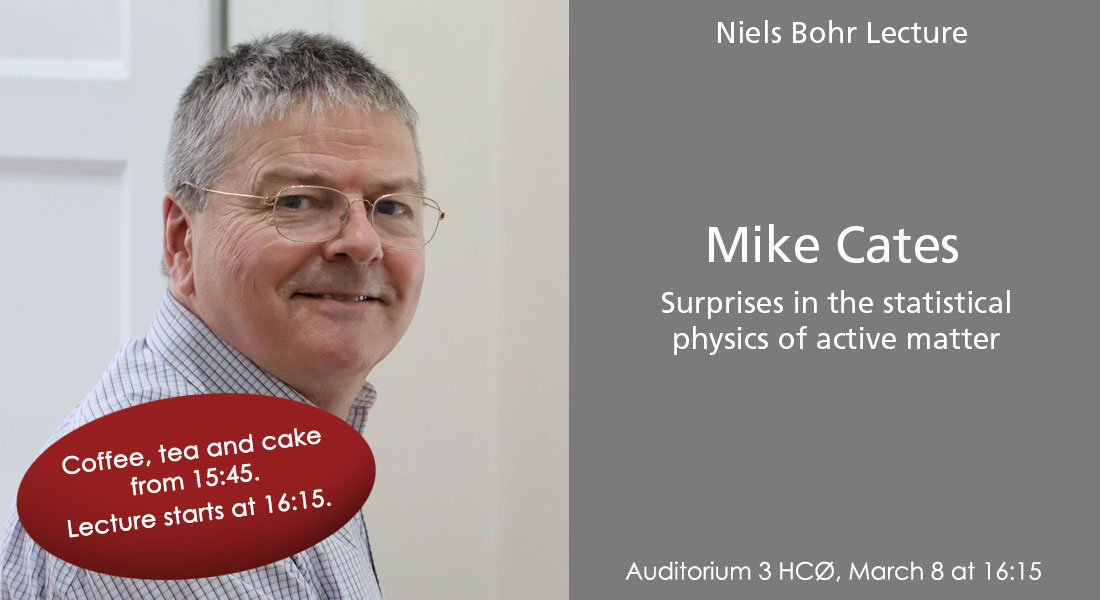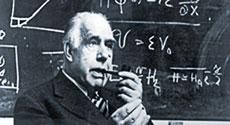Niels Bohr Lecture by professor Mike Cates, University of Cambridge

Surprises in the statistical physics of active matter
Talk by: Professor Mike Cates, University of Cambridge
Abstract: Statistical physics was invented to describe the macroscopic properties of large numbers of particles. It has a hidden weakness: almost all of its results depend on the microscopic forces being reversible. That is, the forces are assumed to derive from a Hamiltonian, or energy function, which governs both the microscopic mechanics and the equilibrium probability distribution (the Boltzmann distribution).
This is why mechanical quantities like pressure are not only time averages of forces (on a wall) but also thermodynamic state functions (which exist independently of any wall).
Active matter systems are different. Their particles take energy out of the environment, and use it for self-propulsion; the resulting dissipation breaks microscopic time-reversal symmetry. Examples include swimming micro-organisms, and synthetic colloids propelled by optical or chemical energy. In such cases there is no Hamiltonian: the usual connection between interaction forces and macroscopic behaviour is broken.
I will describe recent advances in statistical physics for active matter systems, focussing on some of their surprising properties, such as the following. (i) Random motion in a bath of active particles can be globally rectified into a steady current by introducing inert, asymmetric obstacles. (ii) Fluid-fluid phase separation can arise among active particles in the complete absence of the attractive interactions that cause this in equilibrium. (iii) The pressure of an active fluid on a wall is not a state function -- it depends on the type of wall. (iv) Various interfacial phenomena, governed in equilibrium by a single surface tension, now depend on several distinct tensions, which need not all be positive.
About the speaker:
Mike is a member of the Department of Applied Mathematics and Theoretical Physics. He heads the Soft Matter research group. His current research interests include: flow of colloids, polymers, emulsions, gels and other soft materials; shear-thickening and rheology in dense suspensions; dynamics of soft glasses; flow of liquid crystals; general theories of active matter; cellular locomotion; phase ordering in active and passive systems; statistical mechanics of active particles; and numerous other topics. He currently holds an ERC Advanced Grant called ADNeSP: Active and Driven Systems, Nonequilibrium Statistical Physics.
Prizes and Awards
- 2021: International Member, US National Academy of Sciences
- 2019: International Member, US National Academy of Engineering
- 2016: Bingham Medal, US Society of Rheology
- 2013: Weissenberg Award, European Society of Rheology
- 2009: Dirac Medal and Prize, Institute of Physics
- 2009: Gold Medal, British Society of Rheology
- 2007: Fellow of the Royal Society (London)
- 2005: Fellow of the Royal Society of Edinburgh
- 1996: Fellow of the Institute of Physics
- 1994: Prix Franco-Britannique (Paris Academy of Sciences)
- 1991: Maxwell Prize and Medal, Institute of Physics
There will be coffee, tea and cake from 15:45. Lecture starts at 16:15.
|

 Niels Bohr Lectures
Niels Bohr Lectures